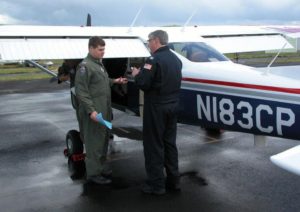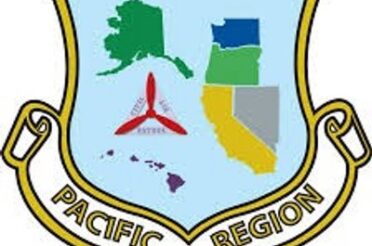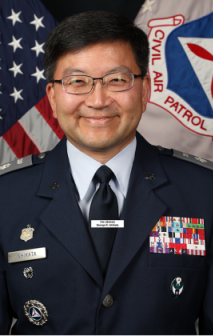Civil Air Patrol members conducted several aerial photography missions Tuesday to continue working an earthquake scenario emergency recovery drill after most other agencies have stood down.
Oregon and Washington CAP personnel conducted activities this week to extend an exercise that began last week. Oregon and Washington launched Cascadia Rising as a major response to a 9.0 magnitude earthquake off the coast. Many agencies including CAP put in four days of exercises last week responding to power outages, road and bridge damage and the opening of emergency shelters. This week Civil Air Patrol is working under the Ardent Sentry scenario, which is a simulation that is several days farther into the crisis.
At least two flights were launched Tuesday after a day of waiting for showers, heavy clouds and thunder and lightning to pass through the area. The teams of three highly trained CAP members were flying photography missions to assess damage. The task for the day is to photograph U.S. Highway 101 from California to Washington. The photos will be delivered to the 1st Air Force, which will share with federal and state authorities to assess earthquake or flood damage and debris. Tsunamis often are triggered by earthquakes and can wash out or undermine coastal roads.
Personnel have reported to the Incident Command Post at the Bend Municipal Airport with Aurora working as a staging area dispatching flight crews, as able, from Salem, Medford and Aurora.
Yesterday, pilots flew missions so their crews could photograph Interstate 5 from Eugene to Wilsonville.
In a real-world earthquake such as the scenario is modeled upon, many airports and aircraft that normally would be used to perform these functions in Oregon would be damaged and unavailable. So, CAP would call in aircraft and aircrews from other states to fly into Oregon and assist.
Ardent Sentry continues through Friday. CAP works under the U.S. Air Force, specifically the 1st Air Force, for missions like this.
Civil Air Patrol was founded on Dec. 1, 1941, by a group of aviation enthusiasts and private pilots who wanted to donate their time and aircraft to protect the nation’s coastlines during World War II and to perform other critical civil defense missions.
Civil Air Patrol, the longtime all-volunteer U.S. Air Force auxiliary, is the newest member of the Air Force’s Total Force, which consists of regular Air Force, Air National Guard and the Air Force Reserve, along with Air Force retired military and civilian employees. CAP, in its Total Force role, operates a fleet of 550 aircraft and performs about 90 percent of continental U.S. inland search and rescue missions as tasked by the Air Force Rescue Coordination Center and is credited by the AFRCC with saving an average of 78 lives annually.
Civil Air Patrol’s 56,000 members nationwide also perform homeland security, disaster relief and drug interdiction missions at the request of federal, state and local agencies. Its members additionally play a leading role in aerospace education and serve as mentors to more than 24,000 young people currently participating in the CAP cadet program. Performing missions for America for the past 75 years, CAP received the Congressional Gold Medal in 2014 in honor of the heroic efforts of its World War II veterans. CAP also participates in Wreaths Across America, an initiative to remember, honor and teach about the sacrifices of U.S. military veterans. Visit www.capvolunteernow.com for more information.





